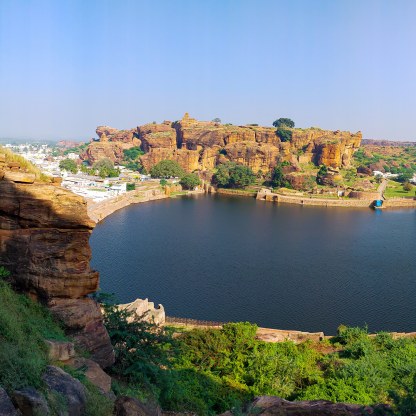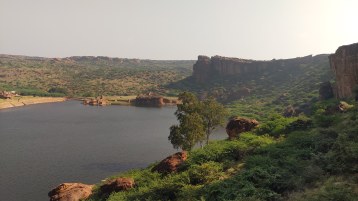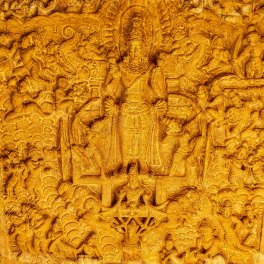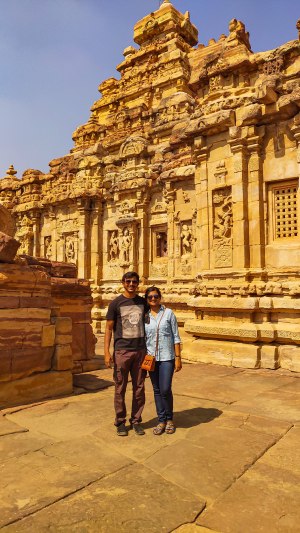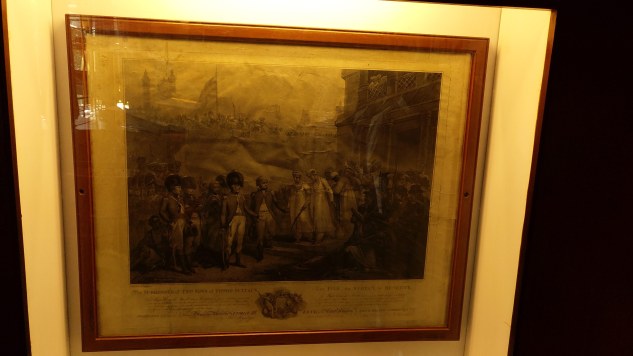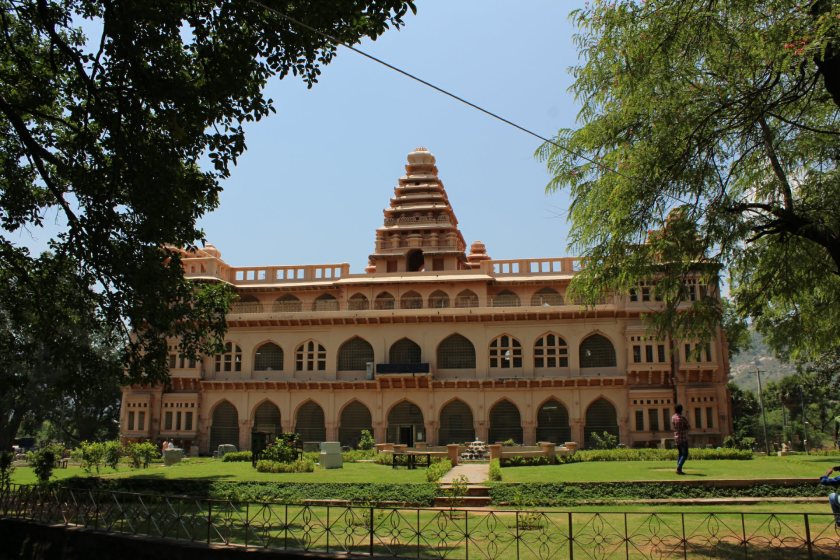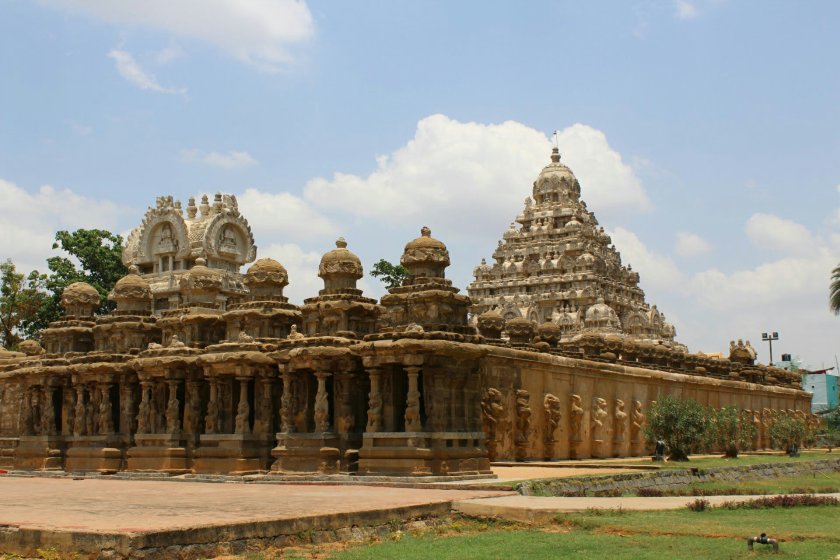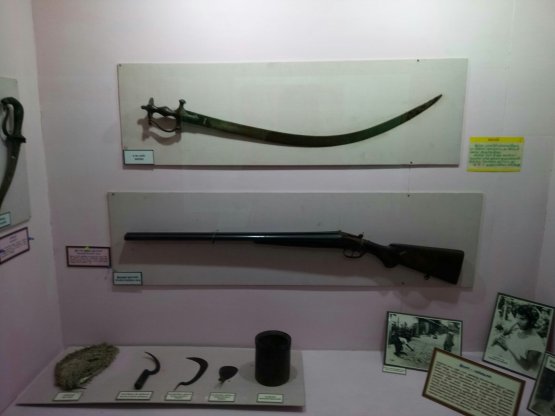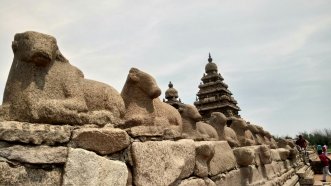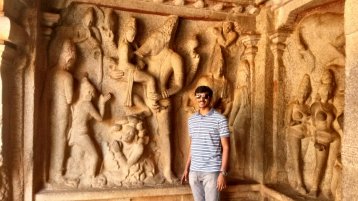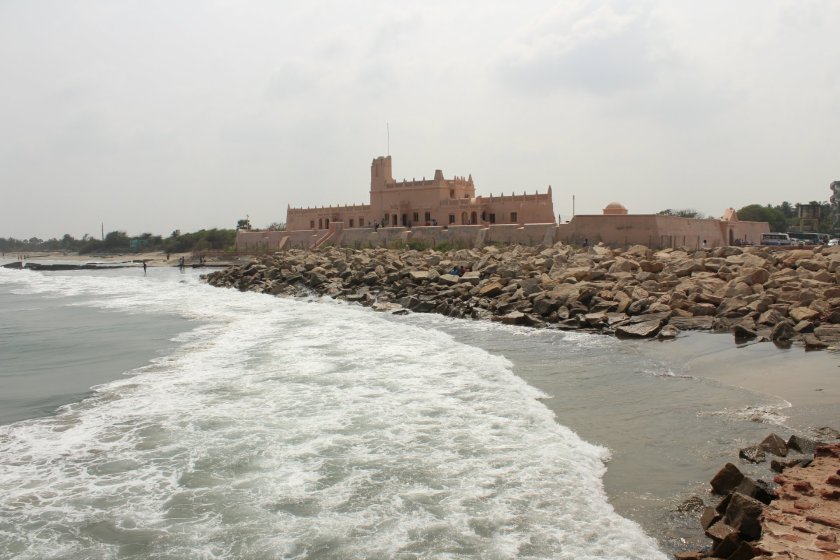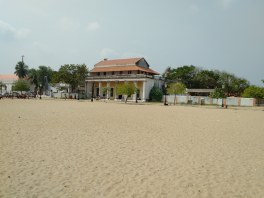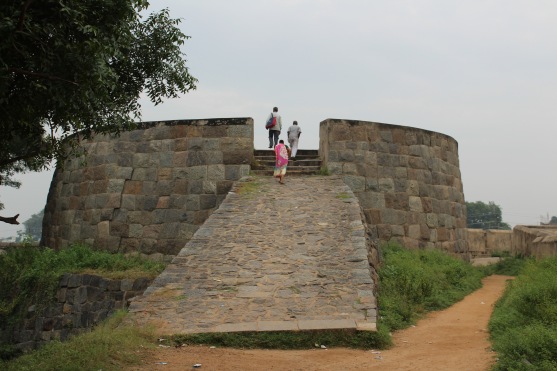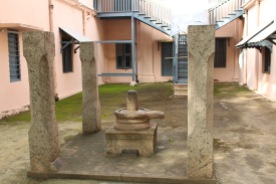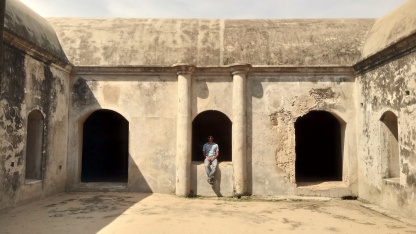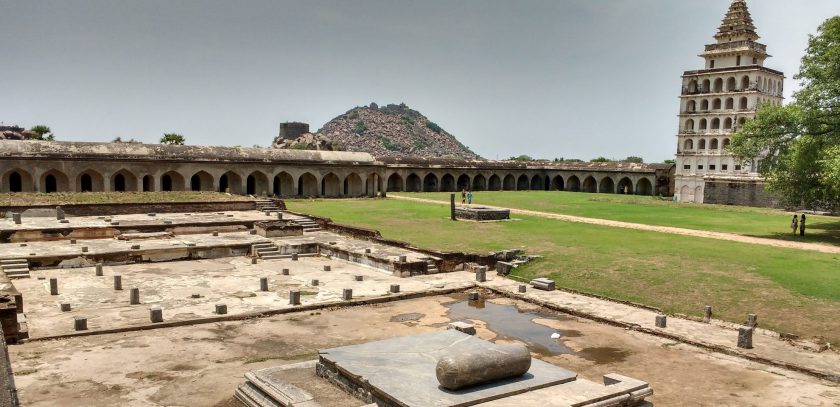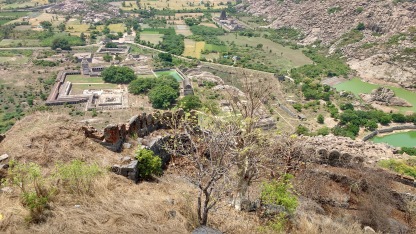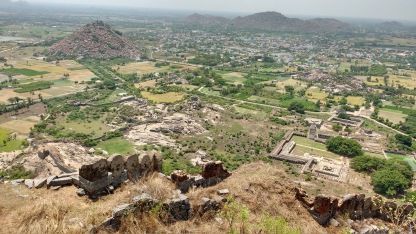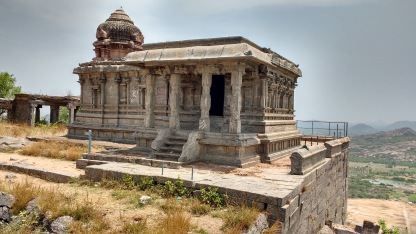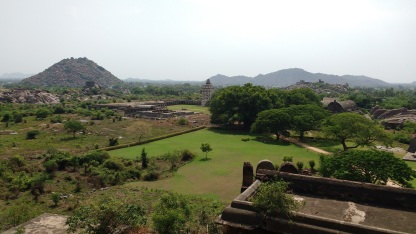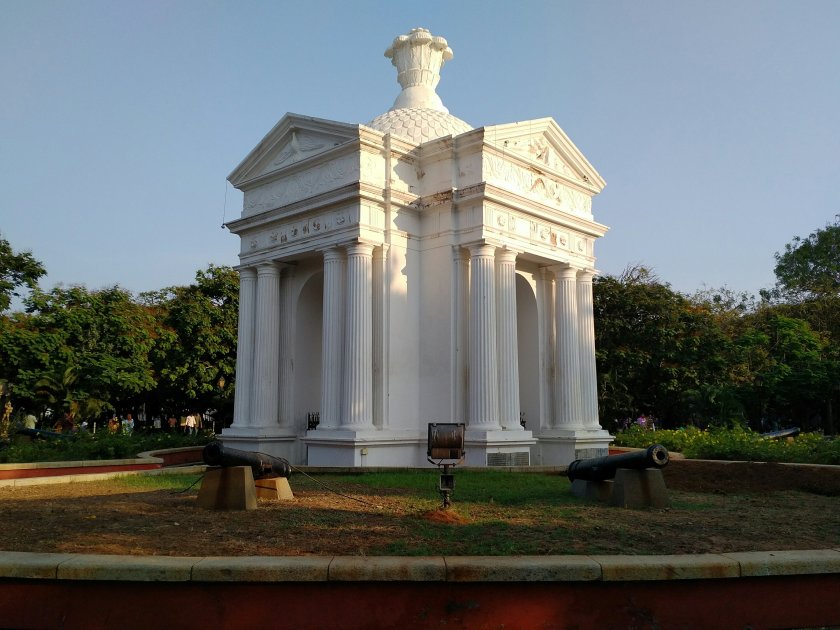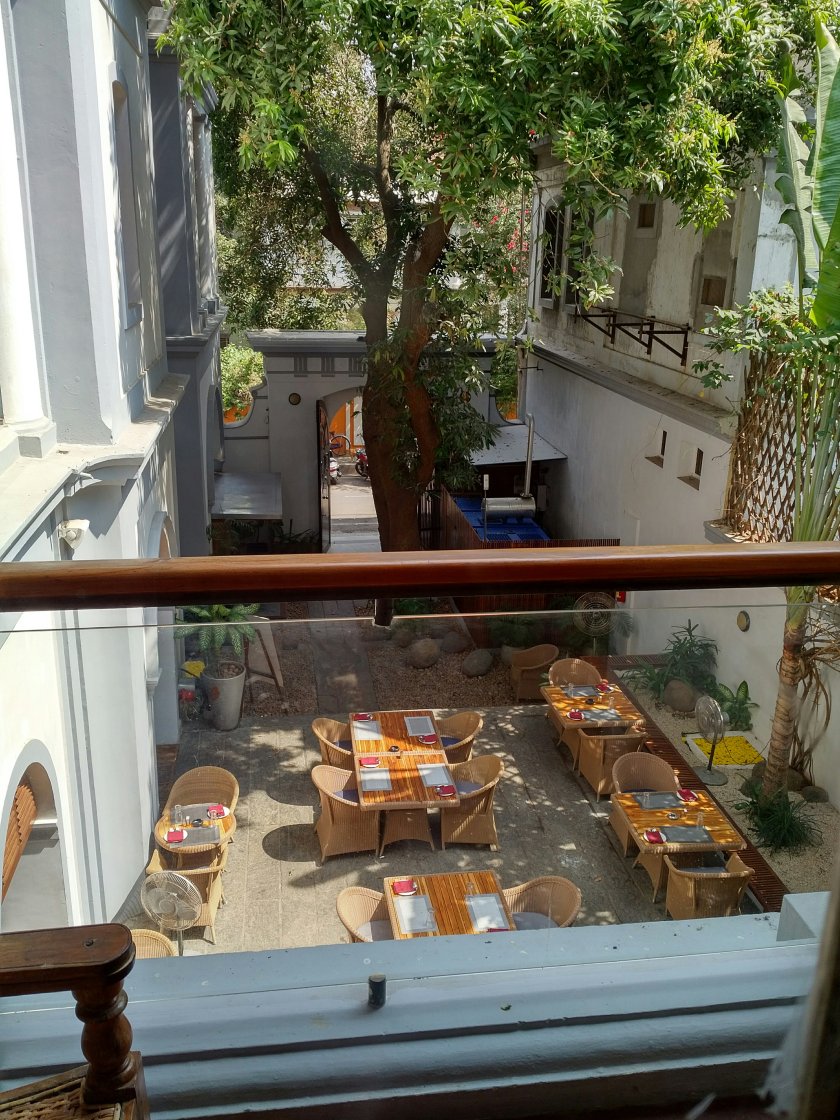The Crown Prince of the Chalukyas looked down on the ruins of Vatapi from top of the hill. The broken walls of the city, the temples which the Pallavas had destroyed. The caves of Vatapi had survived the pillage off the Pallavas. The damage to the pride of Chalukyas was more significant than the financial losses.
His ancestor, Pulakesin had taken the taken the Chalukya dynasty to its greatest heights when he defeated the Lord of North India, King Harshavardhana. He had wiped the smile of “Harsha’s” face. He was the Lord of all of India. All of India, except Kanchipuram. He had been blindsided by the Pallavas of Kanchipuram when he turned his attention North. He had underestimated them and did not think a minor kingdom ruling just one city could challenge the mightiest king of India. The oversight cost him greatly. The young Pallava king, Narasimhavarman had not only defeated the Chalukya army which had gone to capture Kanchipuram, but for good measure marched across the Deccan and destroyed the Chalukyas capital of Vatapi. Pulakesin was killed in battle. The Pallavas turned to dust their city and their name.
Vikramaditya picked up a rock and threw it in to the lake. He would avenge the Chalukya name. He would make the Pallavas rue the day they crossed the Tungabhadra. He would make them regret turning their eyes towards Vatapi. That was his vow. He was Vikramaditya; named after the legendary emperor of ancient India, he would write a few legends of his own. He stood up and walked towards the wooden palace of his father. He would ask for his permission to march his armies down to Kanchipuram and avenge the death of his hallowed ancestor.
Vikramaditya bowed down before his father, the Chalukya king, Vijayaditya. Vijayaditya grimaced uncomfortably at his request to attack Kanchipuram. He slowly climbed up from his throne and came down the stairs. He put his hand on the shoulders of the bowed form of Vikramaditya.
“Find out three things and I will fund your campaign myself against the Pallavas. Find out why you should attack the Pallavas, find a good reason so that out kingdom doesn’t face the wrath of the gods for an unprovoked attack. Find out when it is a good time to attack the Pallavas. Find out who would help you in your campaign. Return to me when you have answers to these three things.”
He turned and climbed back up his throne.
Vikramaditya understood. His father was far more clever than he had anticipated. He wanted him to be truly ready before the attack on Kanchipuram. He wanted him to find a good excuse to attack Kanchipuram so that the brahmins would not protest the desecration of a holy city. He wanted to sow the seeds of discord among the Pallavas and weaken them. He wanted him to find an ally in his campaign against the Pallavas.
The Pallava king, Paramesvaravarman II, did not have an heir. He sent his ministers and commanders on an expedition to all the nearby nations, to find a suitable heir. Vikramaditya invited Chitramaya and told him about his plan. Chitramaya was the nephew of the Ganga dynasty prince, Ereyappa. He was the ambassador of the Gangas and descendant of the great Pallava king Mahendravarman through his mother. Vikramaditya encouraged Chitramaya to put forward his claim as the rightful heir of the Pallava throne after Paramesvaravarman II.
Chitramaya went to Kanchipuram for the great sabha where the discussions for the next heir of Kanchipuram were considered. The Cholas, Pandyas and Cheras had sent their delegations with their choice candidates. Chitramaya came representing the Chalukyas and the Gangas. The king of Kabujadesa (Cambodia) had also sent a candidate, a 12 year old boy called Nandivarman, who claimed to belong to the collateral Pallava line of the Kadavas.
Parameshvaravarman stood on a platform overlooking the arena. He leaned on his walking stick. He turned towards his ministers and nodded. The Prime Minister walked forward and raised his hands. The arena fell quiet.
“The great king Paramesvaravarman, the second, the Parameswara, Satyashraya, Prithvivallabha, and Dakshinapatheswara, thanks you all for presenting yourselves as we decide the question of his heir. I would like to announce at the onset that the ones who are not chosen to be the heir will be killed. We cannot afford anyone to challenge the heir once he is chosen. Anyone who wants to withdraw can withdraw now.”
The delegated princes looked at their sponsors in disbelief. Murmurs filled the arena.
“We the Pandyas withdraw our nominee.”
“The Cholamandalam withdraws its nominee.”
“The Chera nominee withdraws.”
The arena started to empty itself. In the end, only two delegates were left. Nadivarman, the Cambodian delegate and Chitramaya the Ganga delegate, backed by the Chalukyas. Paramesvaravarman turned to his General and nodded his head. The General gave a command and two archers shot at the probable-princes. The 12 year old Nandivarman nimble moved out of the arrow’s way as it dug in the ground behind him harmlessly. Chitramaya who was looking at Vikramaditya in the gallery was not so lucky. The arrow caught him the throat. His collapsed, spluttering blood over the ground, died.
Vikramaditya smiled. He had all three answers. He now had an excuse to attack Kanchipuram. He had an ally in the Ganga king, who’s nephew the Pallavas had killed and the timing was perfect with a 12 year old foreigner boy-king as the crown prince of the Pallavas.
Vikramaditya removed his footwear as he entered the temple complex of Pattadakal. If Vatapi was the heart of the Chalukya empire, Pattadakal was its soul. Built on the banks of Malaprabha river, the only river in the area to flow in a north-south direction. It was the place of coronation of the Chalukya kings. Flanked by his two queens, Vikramaditya bowed down before the priests and thee courtiers. His father put the ‘patta’ around his forehead, anointing him as the crown prince and the commander of the Chalukya armies. A loud cheer filled the complex. His queens, Lokadevi and Trilokadevi came in front of the gathering and held their hands out in the fire..
“We vow with agni as our witness that if our lord Vikramaditya returns victorious from his campaign, we will each build a temple.”
The people cheered for their crown prince and his consorts. The old king Vijayaditya smiled and blessed him.
He saw the Ganga king Sripurusha among the dignitaries. He walked up to him and bowed.
“We go to avenge the death of your grand-nephew. Will you aid us in the battle?”
Sripurusha nodded.
The city of Kanchipuram was busy with preparations of coronation of the adopted king, Nandivarman. The city was covered in colours and flowers. A million scents mingled through the streets and the walls. Music permeated the atmosphere. At night a thousand lamps lit the city up and it seemed that the night sky had come down on earth to celebrate the coronation of the new king. The city overwhelmed all the senses.
Parameshvaravarman sat in his throne room looking over the finances of the upcoming coronation when a messenger ran into his presence and fell on his floor. His clothes were mud-stained and he almost collapsed out of exhaustion.
“Oh great king, I have ridden without rest for a hundred miles. My horse collapsed and died near Raja-vellore, I have run the rest of the way. I bring you an urgent news. The Chalukya army has been mustered and they are marching. I saw them crossing the Tungabadhra. They ride fast and ride lightly. They are marching south. They ride to Kanchipuram.”
The king dropped his ledger as his stood up.
“Who leads them? The Chalukya king Vijayaditya is old and weak. He is in no state to lead an army.”
“My king, it is not Vijayaditya, but the crown prince Vikramaditya who leads them.”
The king remembered the ambitious young prince with a fiery gaze, who had accompanied the Ganga delegation.
“Summon the generals and prepare the war room. Sound the bells. Close the city gates. Suspend the festivities. We prepare for war”, Parameshvaravarman commanded in a quiet voice.
“Vikramaditya is a fool to attack in the summer. His army is going to die of exhaustion. His army is travelling light to gain speed and surprise. That will be against him in this weather. He will run out of food and water. We will face a half-dead army and we will rout them like your ancestor Narasimhavarman did. Do not fear my king”, Sivapadam, the general of the Pallava army assured him.
The king rubbed the ruby on his finger.
“But why is he rushing in the summer? What advantage does that provide?”
“The river Palar is dry. When Pulakesin attacked Kanchipuram in the past, the river delayed his assault and the delay cost him the city. He wants to avoid fording a full river. May be that is why he is attacking the city in the heat of the summer.”
The commanders nodded in agreement.
“Prepare the defence. Mount the spikes on the walls. Prepare the vats of pepper which we used to repel their elephant forces the last time. Do not meet them head on in the field. Starve them out. They can’t maintain a siege for long in this summer”, the king said as his stood up and walked out of the tent.
“Long live Parameshvaravarman. Long live the defender of our faith.”
Vikramaditya watched across the bank of Palar to the city of Kanchipuram. The doors were shut and the walls were well defended. His army was tired and thirsty. He had already lost a hundred men to the heat and exhaustion. The river was dry as he had expected, which proved as a blessing and a curse. It was the season for the rice harvest and food was not a problem for his army. The army was living off the fertile Pallava land; but there was no water.
He walked back into his tent and summoned his commanders and generals.
“The city is shut in and we do not have the supplies or the time to maintain a long siege. The summer heat and the lack of water is hurting the morale of the troops. We need to find a source of water and we need to provoke the Pallava army to come out of the city and meet us in battle on the plains outside. A siege will be a disaster for us.”
The master of the scouts asked for permission to speak. Vikramaditya nodded.
“Oh king, 30 miles to the east at Arcot, the Pallavas have built an anaicut on the river to store water for irrigation. That could sustain our army for a month or so till the monsoon rains arrive. We could move our camp there. We will return with supplies and siege material after the rains.”
Vikramaditya held his forehead as he considered the advice.
“We will move our camp to Arcot, but we will not wait till monsoon. Once the river flows we will be trapped on either of its banks and we will be ripe fruits to be massacred by the Pallavas. They are currently stunned by the rapidity of our advance, but the more we stay here, the more they will recruit allies and we will be left in the dark.”
“Oh king, what about our allies?”, asked Jeyasimha, the commander of the cavalry.
Vikramaditya frowned and looked towards the North in silence.
Parameshvaravarman watched the empty plains around Kanchipuram. The Chalukya army had retreated back to Arcot. He asked the Chola and Pandya ambassadors in his court to ride to Thanjavur and Madurai to ask for help in this war. His generals were standing behind him and discussing what would be the best course of action now.
“Rajan, should we pursue them to Arcot and attack them. They are weary and tired. They will be easy meat for our army. We don’t need the Chola and Pandya allies to wipe them out.”
“Rajan, I think we should stay in the city and wait for them to attack. They do not have the resources to maintain a siege. The longer we draw them out. The more they will suffer.”
The king turned to the court-astrologer and asked,
“Aiya, what do the stars suggest?”
“Rajan, the auspicious time for the prince’s coronation is near. If the coronation does not proceed on time, I see dark times for the Pallavas in the future. The way ahead is not clear to me, but, I see that the coronation must proceed.
“Prepare for the coronation”, Parameshvaravarman announced.
The generals and the courtiers bowed in agreement.
At the moment, a loud noise like a rumbling thunder from the east caught their attention. They saw a cloud of dust rising from the east. Vikramaditya was mad. He was attacking.
The war horns sounded and the bells rang. The generals looked to their king for their orders.
“We do not have time for a siege, the coronation must proceed as planned. Muster the armies, meet Vikramaditya on the field and wipe him from the face of this earth. Show them what it means to provoke the Pallavas.”
The summoning horns were sounded and the commanders rushed to their troops.
Vikramaditya could not believe his eyes. The Pallavas could not be foolish enough to meet him on the field. He had sent a portion of his troop as a bait to drag the Pallavas out of the security of their walled city. He hadn’t expected it to work, but it had.
The entire Pallava army had been mustered. The elephant troops in the front, the infantry behind them and the cavalry in the flanks. The archers were in the back. They outnumbered the Chalukyas by three times.
The advance troop of the Chalukya army turned around and retreated. The Pallava army gave them a chase. Vikramaditya gave the signal. The main army which was hidden in the southern woods came out of their hiding and attacked the Pallava army from the rear. The archers and infantry were poorly defended. The fast Chalukya cavalry cut them down and retreated back to the forest.
The Pallava formation turned around to deal with the attack from the rear. The retreating Pallava advanced force which was fleeing from Pallava attack, turned around and smashed into the elephant troops.
The surprise attacks caused chaos in the Pallava ranks, but they recovered themselves. The right cavalry turned around and attacked the Chalukya calvary from the forest while the left cavalry advanced and took on the Chalukya advance troops. The archers had regrouped and firing volleys into the forest.
Vikramaditya sat on his horse and looked at the destruction around him. His army in the woods was getting cut down by the archers. The advance force was almost decimated and the elephant troops had turned their attention towards them. The end was near. He had dreamed big, but the reality was crumbling around him. This was going to be his end. That is when he heard them.
The horns.
Horns from the North.
The Gangas had come. King Sripurusha had come. His allies had not abandoned him.
An arrow took him through the shoulder and he fell off the horse.
Vikramaditya entered Kanchipuram on his elephant. His shoulder was in a sling made of cotton and filled with medicinal herbs. He was flanked on his right by the Ganga king Sripurusha. The combined Ganga and Chalukya forced had beaten back the Pallavas. The Pallava army had surrendered and the gates of Kanchipuram had been opened.
The Chalukya armies yelled in triumph. Cries of plunder and destruction of the city went through the army. They were thirsty for revenge. They wanted payback for Pulakesin’s death.
“No! No plunder, no destruction”, Vikramaditya commanded his troops.
Silence.
“This is a holy city and we have had our revenge. I will offer my prayers at the Kailasantha temple. That is all we came here for. No one will steal or slaughter anyone in this city.”
A cheer went forth, this time from the people of Kanchipuram. The priests of the temple came out and chanted prayers for him.
The conqueror of Kanchipuram entered the city he conquered with flowers raining on him.
Vikramaditya was crowned as king after his father passed away. His wives built a temple each commemarting his victory. The Pallava King Parameshvaravarman pledged fealty to him. His son was promised in marriage to Sripurusha’s daughter.
He turned and looked towards heaven.
“Oh Pulakesin, my most hallowed ancestor. I have avenged your death.
The town of Vatapi, now known as Badami, lies an overnight bus journey away from Bangalore. It reached its heyday under Pulakesin, when it was the capital of all of India. After Pulakesin’s defeat and death at the hands of the Pallava king Narasimhavarma (to read the story of Pulakesin’s defeat and the fall of Vatapi, click here), it slowly faded into obscurity, till the Vikramaditya brought it back to its glory. Vikramaditya attacked Kanchipuram and defeated the Pallavas three times in his life, once as a crown-prince, once as the Chalukya king and once when his son was the crown prince. Each time he made sure that his army did not destroy or sack the town.
The town of Badami is a semi-circular hill around a lake. The cave-temples of Badami are a sight to behold. A series of caves with beautiful Hindu and Jain carvings built in a stepwise pattern on the hillside. Another wonder to behold is the Bhootnath temple complex on the shore of the lake. The surrounding hill was used a fortress by Tipu Sultan and can can be trekked up to.
The town of Pattadakal (now an UNESCO world heritage site) is 20 km away from Badami. Situated on the banks of river Malaprabha, it was the site of coronation of the Chalukya kings. It is called an university of architecture and filled with temple complexes in both northern and southern styles. One can see the Chalukya architects experimenting with different styles in the same place. The temples built by Vikramaditya’s wives, Lokadevi and Trilokadevi are still surviving. The temples are filled with carvings of Mahabharata, Ramayana and even takes from Panchatantra.
At the center of the monuments is a stone pillar, installed by Vikramaditya, describing his victory over the Pallavas and his capture of the holy city of Kanchipuram.





















